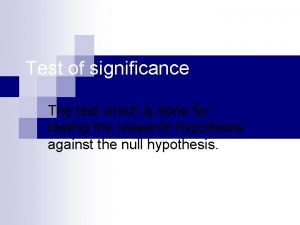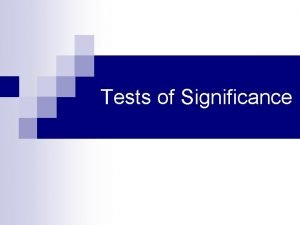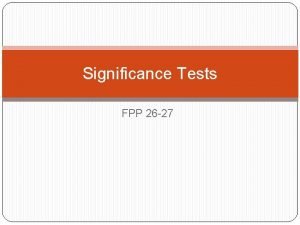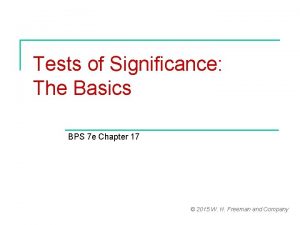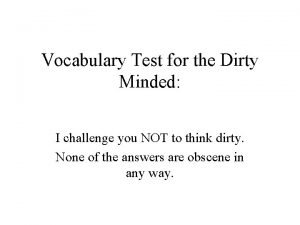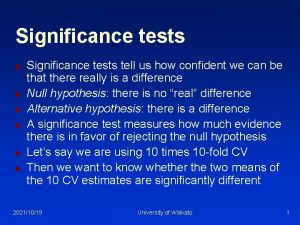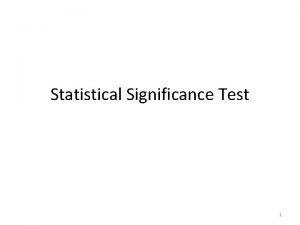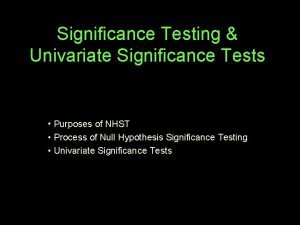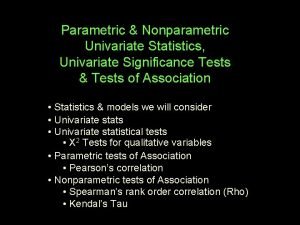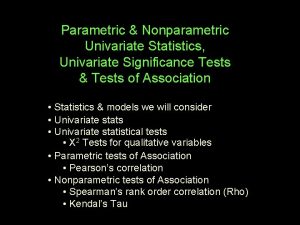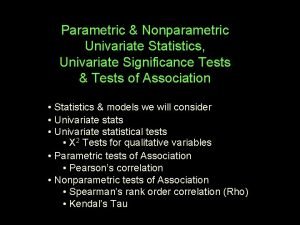Tests of significance A test of significance is













- Slides: 13

Tests of significance • A test of significance is a method for using sample data to decide between two competing claims about a population characteristic. • Tell us if the difference is statistically significant –an observed effect so large it would rarely occur “by chance alone”. – A random occurrence due to variation – Biased occurrence due to some other reason

Testing Hypotheses About Proportions Chapter 20

Definitions • The null hypothesis, denoted by H 0, says that there is no effect or no change to a claim assumed to be true. • The alternative hypothesis, denoted by Ha, is the competing claim.

The form: Null hypothesis H 0: parameter = hypothesized value Alternative hypothesis Ha: parameter > hypothesized value Ha: parameter < hypothesized value Ha: parameter hypothesized value

Assumptions for Inference • SRS from the population • Independent: Reasonable and the population is at least 10 times as large as the sample. • np > 10 and n(1 – p) > 10, therefore we can use a normal model for our sampling distribution

P-values • The probability that the test statistic would have a value as extreme or more than what is actually observed

Tests of significance

Test of Significance To test the hypothesis Ho : p = po

Significant Level or Alpha Level • The threshold P-value that determines when we reject a null hypothesis. • Represented by the Greek letter alpha (a) • Common alpha levels are 0. 10, 0. 05, and 0. 01. – You have the option—almost the obligation— to consider your alpha level carefully and choose an appropriate one for the situation.

• A p-value as small or smaller than the level of significance (a) is “statistically significant” at that alpha level • If p-value > a, “fail to reject” the null hypothesis at the a level. • If p-value < a, “reject” the null hypothesis at the a level.

Never “accept” the null hypothesis!

Since the p-value of ______ is < (> or ≠) of _____, I reject (fail to reject) the null hypothesis. There is (not) sufficient evidence to suggest that alternative hypothesis in context. (Answer the question or make a concluding statement).

Steps There are four basic parts to a hypothesis test: 1. Hypotheses 2. Assumptions (Model) 3. Mechanics 4. Conclusion – – – The conclusion in a hypothesis test is always a statement about the null hypothesis. The conclusion must state either that we reject or that we fail to reject the null hypothesis. And, as always, the conclusion should be stated in context.
 Ace different tests help iq but
Ace different tests help iq but Test of significance
Test of significance Unit 10, unit 10 review tests, unit 10 general test
Unit 10, unit 10 review tests, unit 10 general test Population parameter
Population parameter Significance test
Significance test What is a significance test
What is a significance test Test of significance
Test of significance Wigan lea mental maths
Wigan lea mental maths Bod apes
Bod apes Romberga tests
Romberga tests Dirty-minded words
Dirty-minded words Uil number sense practice tests high school
Uil number sense practice tests high school Uil number sense scoring
Uil number sense scoring Mechanical reasoning test
Mechanical reasoning test

